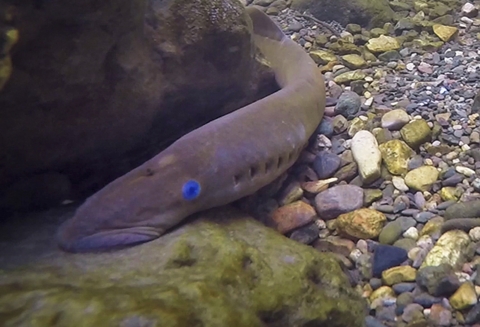Sea lamprey is an invasive species invasive species
An invasive species is any plant or animal that has spread or been introduced into a new area where they are, or could, cause harm to the environment, economy, or human, animal, or plant health. Their unwelcome presence can destroy ecosystems and cost millions of dollars.
Learn more about invasive species that entered the Great Lakes in the late 1800s. Each adult sea lamprey can destroy up to 40 pounds of Great Lakes fish. Before sea lampreys were brought under control, the species destroyed commercial and recreational fisheries, causing the collapse of the Great Lakes fishing economy. Collaborative efforts have reduced invasive sea lamprey populations by 90% in most areas of the Great Lakes and allowed for the rehabilitation of a healthy Great Lakes ecosystem, an economy now valued at more than $7 billion annually.
What are invasive sea lamprey?
Members of an ancient family of jawless fishes that have been around since before the dinosaurs, invasive sea lamprey are eel-like animals that can be a foot or longer. With impressive circular mouths lined with rows of teeth, sea lamprey are efficient predators.
Originally native to the Atlantic Ocean, their advancement into the Upper Great Lakes was hindered by the impassable Niagara Falls. However, when shipping routes that bypassed the falls were built, sea lamprey gained access to the entire Great Lakes system. By the 1930s, these invasive fish had infested all of the Upper Great Lakes.
How did they devastate the Great Lakes?
The harm caused by sea lamprey extends beyond individual fish deaths; they severely disrupt native fish populations and outcompete for resources. In the past, lakes Huron, Michigan and Superior were known for their large, high-quality cold-water fish and generated immense profits for commercial fisheries. In the 1940s, lake trout alone accounted for an average annual commercial catch of 7,000 tons. However, the invasion of sea lamprey led to a drastic decline in lake trout populations which resulted in the closure of the fishing season in 1962, after a complete population collapse.
Why don’t I see sea lamprey today?
In response to the ecological and economic crisis brought on by invasive sea lamprey and acting through the Great Lakes Fishery Commission, we launched a major chemical control effort in the 1950s.
We worked to identify a chemical, known as a lampricide, that is effective at controlling sea lamprey larvae without significantly impacting other species. Scientists tested nearly 6,000 chemical compounds before identifying 3-trifluoromethyl-4-nitrophenol, a lampricide referred to as TFM. This is the treatment that we use today.
Biologists apply TFM to lamprey-infested streams around the Great Lakes, and we’ve seen incredible positive impacts. By the early 1960s, these treatments had successfully reduced sea lamprey populations by 90% and allowed for the recovery of self-sustaining populations of native lake trout in parts of the Upper Great Lakes.
Lampricides are selectively toxic to sea lampreys, though we’ve found a few fish, insects and broadleaf plants that are also sensitive. We have used TFM successfully for more than 60 years to suppress sea lamprey populations in the Great Lakes. This chemical compound naturally degrades in the ecosystem, which prevents biomagnification and has been determined by the U.S. Environmental Protection Agency to pose no unreasonable risk to the general population and environment.
While completely eliminating sea lamprey populations from the Great Lakes is unlikely, our ongoing management strategies are making headway. Continued lampricide treatments, along with new technologies, such as mechanical and electrical barriers, are contributing to healthier fish populations. As lake trout restoration efforts expand, controlling sea lamprey remains a priority for our team.
The Great Lakes Fishery Commission oversees and funds sea lamprey management throughout the Great Lakes region, while Fisheries and Oceans Canada takes charge of management in Canadian waters.
Sea lamprey aren't the only lamprey!
Native lampreys are meant to exist in our ecosystem and don't have the devastating effects of invasive sea lamprey. While we work to remove invasive sea lamprey from the Great Lakes, there are also several species of native lamprey in the Great Lakes fishery. We also work to restore native Pacific lamprey on the West Coast.
Want to learn more?
The Marquette and Ludington Biological Stations in Michigan carry out our Sea Lamprey Control Program. Explore their pages to learn more about our agency's important work with the invasive sea lamprey.











